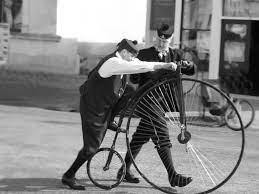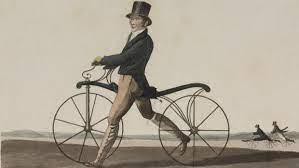The first known iterations of a transport by wheels, powered by human power was created long before bicycle Become a real transport vehicle. According to the International Bicycle Foundation (IBF), in 1418, an Italian engineer, Giovanni Fontana (or de la Fontana), built a human-powered device consisting of four wheels and a loop of wire connected connected by gears.
In 1813, about 400 years after Fontana build a car With his own wheels, a German inventor and aristocrat named Karl von Drais set out to build his own version of the Laufmaschine, a human-powered four-wheeler. Then, in 1817, Drais debuted a two-wheeler, which became known to many names throughout Europe, including the Draisienne, the dashing and hobby horse, the IBF said.

The first bicycles
Bicycles instead of pack horses

The early bicycles were quite bulky.
Drais built his machine to solve a very serious problem: the lack of real horses. In 1815, Indonesia’s Mount Tambora erupted and a cloud of ash dispersed around the world brought down global temperatures. According to the Smithsonian Magazine, crops failed and many animals, including horses, died of starvation.
Drais’ equine hobby was a far cry from the aerodynamic speed machines of today’s bicycles. Weighing in at 23 kg, the bike’s ancestor had two wooden wheels attached to a wooden frame. Riders sit on a leather saddle nailed to the frame and steer the bike with a rudimentary wooden handlebars. There are no gears and no pedals, as the rider simply pushes the gear forward with their feet.
Drais brought his invention to France and England, where it became popular. An English producer and trainer named Denis Johnson marketed his own version, called a “walking toy”, to London aristocrats.
Baron Karl von Drais of France is credited with inventing the “Hobby” or “Princess Horse”, the precursor to the bicycle, in 1817.
Bone shaker

Bicycles were once a luxury hobby.
Bicycles went back to the early 1860s with the introduction of a wooden frame with two steel wheels, pedals and a fixed gear system. Also known as the “bone shaker”, the braves of this original transport are ready for a bumpy ride.
The question of who invented the pedal, and its revolutionary gear system, is a somewhat difficult question to answer. A German named Karl Kech claimed that he was the first to mount a pedal in 1862. But the first patent for such a device was granted not to Kech but to Pierre Lallement, a vehicle manufacturer. French horseman who obtained an American patent for a two-wheeled vehicle with crank pedals in 1866.
In 1864, before securing a patent for his car, Lallement put on a public display of his creation, which might explain how Aime and Rene Olivier – the two sons of a wealthy industrialist in the country Paris – learned of his invention and decided to create a speed car of their own. Together with a classmate, Georges de la Bouglise, the young people invited Pierre Michaux, a blacksmith and chariot builder, to create the parts they needed for their invention.
Michaux and the Olivier brothers began marketing pedal products in 1867, and the device was a huge success. Because of disagreements over design and financial problems, the company that Michaux and Oliviers founded together was eventually dissolved, but Olivier-owned Compagnie Parisienne survived.
By 1870, cyclists were fed up with the bone-rocket design popularized by Michaux, and manufacturers responded with new designs. Also by 1870, metallurgy had progressed to the point where metal bicycle frames could be created, which were stronger and lighter than wood, according to the IBF.
One popular design is the tall car wheel, also known as a deflated due to the size of the wheel. This design is smoother than the previous product with solid rubber tires and long spokes. The front wheel got bigger and bigger as manufacturers realized that the larger the wheel, the further it could move with one revolution of the pedal.
Unfortunately, the big front wheel design championed by young thrill-seekers – many of whom have raced at start-up bike clubs across Europe – doesn’t fit the bill. most racers. If the rider needs to come to a sudden stop, momentum transfers all of the force through the front wheels and lands the rider overhead.
The bike is getting lighter and lighter
An English inventor named John Kemp Starley came up with the winning idea of the “safety bicycle” in the 1870s. Starley began successfully marketing his bicycle in 1871, when he introduced the bicycle. “Ariel” in the UK, kickstarting that country’s role at the forefront of bicycle innovation decades later.
Starley is perhaps best known for inventing the tangential 5-spoke wheel in 1874. This tension-absorbing front wheel was a significant improvement over the wheels found on earlier bicycles. and make cycling a comfortable, enjoyable activity for the first time. Starley’s wheels also make for a much lighter bike, another practical improvement over previous iterations.
Then, in 1885, Starley introduced the “Rover” with roughly equal-sized wheels, central-axle steering, and chain-operated differential gears, the extreme Starley “Rover” stability period and was the first highly practical iteration of the bike.
According to the NMAH, the number of bicycles in use skyrocketed from about 200,000 in 1889 to 1 million in 1899.
At first, bicycles were a relatively expensive hobby, but mass production made bicycles a practical investment for workers, who could then go to work and back home. The bicycle has introduced thousands of individual and independent means of mobility, and offers greater flexibility in terms of recreation.
As women began to ride in bulk, significant changes were required in women’s fashion, especially when it came to cycling skirts.
According to the NMAH, bicycles have a direct influence on the introduction of cars. Bicycle parts were then incorporated into automobile components, including ball bearings, differentials, steel tubes and pneumatic tires.
Many pioneering automobile manufacturers were the first bicycle manufacturers, including Charles Duryea, Alexander Winton, and Albert A. Pope. Also, Wilbur and Orville Wright were bicycle manufacturers before turning their attention to aerodynamics. Glenn Curtiss, another aviation pioneer, also started out as a bicycle manufacturer.
The number of manufacturers dwindled in the early 1900s, and for more than 50 years bicycles were largely used only by children.
Adult interest reawakened in the late 1960s when many people began to consider cycling as a non-polluting, non-congested means of transportation and recreation. In 1970, nearly 5 million bicycles were manufactured in the United States, and an estimated 75 million riders shared 50 million bicycles, making cycling the top outdoor recreational activity in the United States.
In 1896, the American Federation of Wheelchair Riders recognized Tillie Anderson as the best woman cyclist in the world.
Bikes today
According to the Bicycle History website, more than 100 million bicycles are produced each year and an estimated 1 billion bicycles are currently in use around the world.
Today, a person who walks into a bike shop is faced with a plethora of options. Frames are designed and made from different materials based on the bike’s position. They can be made from steel, aluminum, titanium, or carbon fiber, or sometimes from materials like bamboo. Wheels come in a variety of sizes and thicknesses for rolling on a variety of surfaces: from rough mountain roads filled with dirt and rocks to flat paved city roads. Drivers can choose between different types of brakes, number of wheels, seat shape, steering and bend positions, and with or without suspension.
Bicycles can have from one to 33 gears. Saddles can be short and narrow for racing, or wide and padded for comfortable riding.
And some modern bicycle designs are so different from their predecessors that they can be difficult to recognize as the bicycles of the original inventors. Today, bicycles can be folded to make it easier to move or store.
at Blogtuan.info – Source: Soha.vn – Read the original article here



